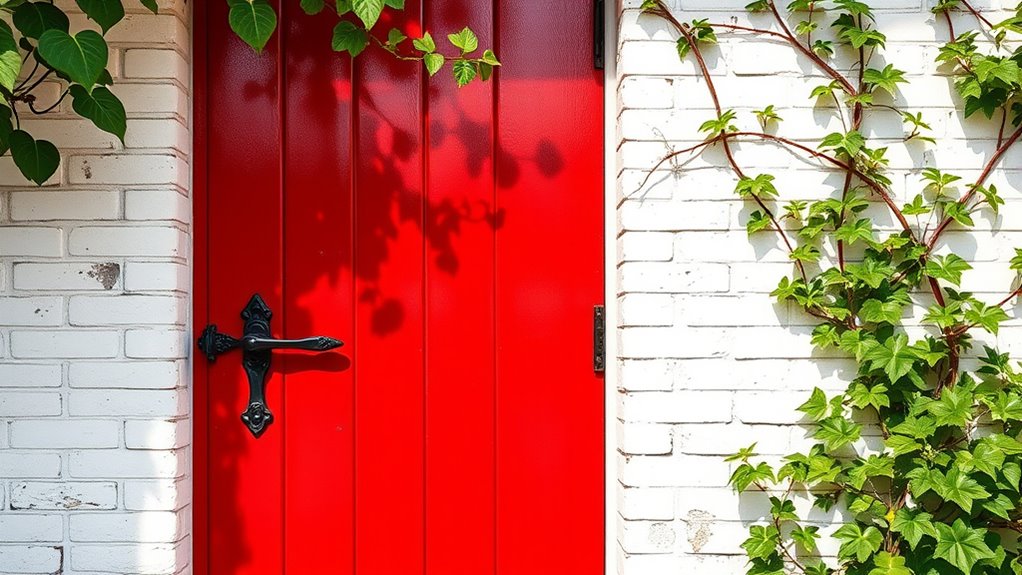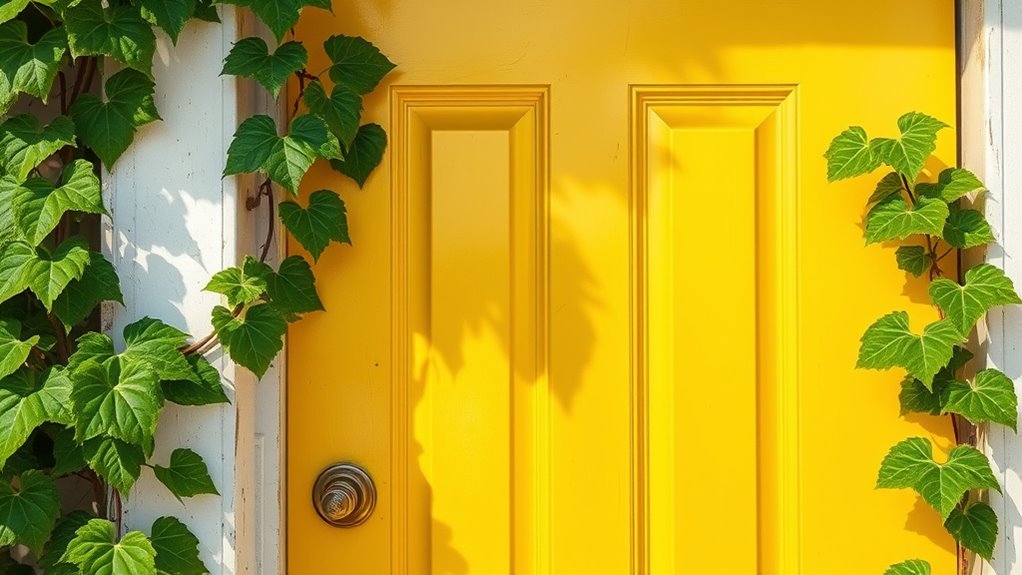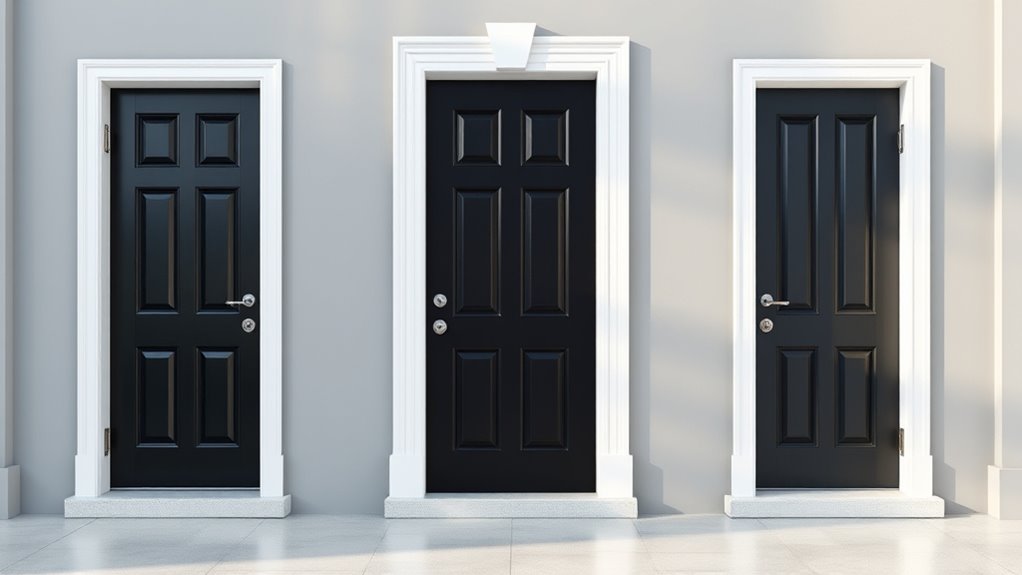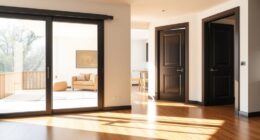Your door color reveals your personality and how you want others to see you. For example, a red door shows confidence and passion, while blue promotes trust and calmness. Yellow and green suggest optimism and growth, and black or white doors reflect elegance and balance. Choosing unique colors expresses creativity and individuality. If you want to understand the surprising messages your door color sends, keep exploring what these shades truly symbolize.
Key Takeaways
- Bold door colors like red or black often indicate confidence, passion, or a desire to stand out and showcase personal style.
- Soft hues such as blue or green suggest trustworthiness, calmness, and a preference for harmony and stability.
- Bright colors like yellow or green reflect optimism, happiness, and a positive outlook on life.
- Unique or unconventional door shades reveal creativity, individuality, and a willingness to break from tradition.
- Well-maintained doors with thoughtfully chosen colors signal attention to detail and pride in personal or professional presentation.
The Significance of Red Doors: Confidence and Passion

Red doors are more than just a bold color choice; they symbolize confidence and passion. In door color psychology, red is known to evoke strong emotions and grab attention immediately. When you choose a red door, it communicates a sense of warmth, energy, and boldness to visitors. The emotional impact is powerful—signaling that you’re confident and welcoming, yet passionate about your space. Red doors can also suggest good luck and prosperity in many cultures. By opting for this vibrant hue, you make a statement that you’re unafraid to stand out and embrace your bold personality. This color choice reflects your desire to project strength, enthusiasm, and a welcoming spirit, leaving a lasting impression on everyone who approaches your home. Additionally, understanding the risks and rewards of bold color choices can help you make an informed decision about your home’s exterior.
Blue Doors and Calmness: Reflecting Tranquility and Trust

Choosing a blue door can instantly set a peaceful tone for your home’s exterior. According to door color psychology, blue evokes calmness, trust, and stability. It signals to visitors that your space is welcoming and reliable. In interior design cues, blue doors often suggest serenity and harmony, making your home feel more relaxing. This color choice can also reflect your personality—someone who values tranquility and openness. Blue doors are versatile, blending well with various styles from classic to modern. By selecting this hue, you communicate a sense of calm that extends beyond your front entrance, creating an inviting atmosphere that reassures guests and passersby alike. Additionally, research in somatic therapy suggests that calming colors like blue can positively influence emotional well-being by promoting relaxation and reducing stress. Overall, a blue door is a simple yet powerful way to express tranquility and trust through your home’s exterior.
Yellow and Green: Optimism, Growth, and Fresh Beginnings

Yellow and green doors can instantly lift your mood and create a welcoming vibe. These bright colors symbolize new opportunities and encourage positive energy to flow into your space. By choosing these hues, you invite growth, optimism, and fresh beginnings into your home.
Bright Colors Boost Mood
Bright colors like yellow and green have a powerful effect on your mood, instantly uplifting your spirits and promoting a sense of optimism. According to door psychology and color psychology, these hues can influence your emotions simply by how they’re perceived. Yellow energizes you, fostering happiness and confidence, while green symbolizes growth and renewal, helping you feel refreshed. Choosing bright-colored doors can create an inviting atmosphere and positively impact your mental state. Here’s how these colors influence your mood:
| Color | Effect | Symbolism |
|---|---|---|
| Yellow | Boosts happiness, confidence | Optimism, energy |
| Green | Promotes calm, growth | Renewal, fresh start |
Opting for these colors in your door paints a mood-boosting environment that aligns with positive psychology principles.
Symbolize New Opportunities
When you see a door painted in yellow or green, it often signals new beginnings and fresh opportunities. In door symbolism and color psychology, these vibrant hues represent optimism, growth, and renewal. A yellow door can suggest a welcoming attitude and a positive outlook, while green indicates progress and potential.
Consider these three insights:
- Yellow doors symbolize joy and encouragement, inviting new ventures.
- Green doors reflect growth, balance, and fresh starts.
- Both colors inspire you to embrace change and seize upcoming opportunities.
Recognizing these color associations can help you better understand your own motivations and aspirations.
Choosing a yellow or green door may reveal your openness to change and your desire for growth. It’s a subtle yet powerful way to communicate your readiness for new chapters and positive transformations.
Invite Positive Energy
Choosing a door painted in yellow or green can set the tone for inviting positive energy into your life. According to door color psychology, yellow radiates optimism and happiness, creating a welcoming atmosphere that lifts spirits. Green symbolizes growth, renewal, and fresh beginnings, encouraging a sense of balance and harmony. When you select these colors, you’re actively inviting positive energy into your home and daily routines. Bright yellow doors can energize you and visitors alike, fostering a cheerful environment. Green doors promote calmness and renewal, inspiring personal growth. By understanding the impact of door color psychology, you can intentionally choose hues that boost your mood and attract positive vibes, making your entrance a powerful symbol of optimism and fresh starts. Incorporating sound design techniques into your home environment, such as ambient sounds or calming music, can further enhance this positive atmosphere.
Black and White Doors: Elegance, Sophistication, and Balance

Black and white doors instantly convey elegance and sophistication, making them a timeless choice for any home. These colors symbolize balance, purity, and authority, reflecting a sense of harmony and style. Historically, door color trends have shifted from bold hues to classic monochromes, emphasizing simplicity and refinement. When choosing a black or white door, consider the door material symbolism—wood signifies warmth and tradition, while metal suggests strength and modernity. To enhance your door’s impact, think about:
Black and white doors exude timeless elegance, symbolizing harmony, strength, and refined simplicity.
- Pairing black doors with gold or silver hardware for a luxurious look
- Using white doors to create a clean, minimalist aesthetic
- Combining contrasting colors with decorative glass for added sophistication
- The psychological impact of color choices on visitors’ perceptions and mood
These choices help express your personality through timeless elegance and balanced design.
Unique and Unconventional Colors: Expressing Creativity and Individuality

Opting for unique and unconventional door colors allows you to showcase your creativity and stand out from the crowd. Bright, bold hues or unexpected shades become a form of artistic expression, turning your door into a statement piece. These colors reflect your desire to break away from tradition and highlight your individuality showcase. By choosing vibrant purples, fiery oranges, or even metallic finishes, you communicate that you value originality and personal flair. Such choices not only make your home memorable but also demonstrate your confidence in expressing your authentic self. With unconventional colors, your door becomes more than an entryway—it transforms into a reflection of your creative spirit and commitment to standing apart. Additionally, embracing halal aesthetics in your choices can further reinforce your personal values while expressing your distinctive style.
How Door Colors Influence Perceptions and First Impressions

The color of your door shapes how visitors perceive your hospitality and warmth. A welcoming hue can create a positive first impression that lasts, while a less inviting color might do the opposite. First impressions matter, and door colors play a key role in setting that tone. Additionally, understanding the personality traits associated with different colors can help you choose a door color that reflects your true self.
Color and Hospitality Perception
When guests approach a hospitality establishment, their first impression often hinges on the color of the door. Door color psychology plays a pivotal role in shaping perceptions and setting the hospitality ambiance. The right color can convey warmth, luxury, or professionalism instantly. Consider these key points:
- Red doors evoke excitement and energy, making guests feel welcomed and enthusiastic to explore.
- Blue doors promote tranquility and trust, ideal for creating a calming, inviting atmosphere.
- Black or dark-colored doors suggest sophistication and exclusivity, elevating the perceived quality of your venue.
- The signs of spoilage in unexpected elements like door decoration or maintenance can influence first impressions just as much as color choice.
Choosing the right door color aligns with your desired hospitality perception, influencing how visitors perceive your space before they even step inside.
First Impressions Matter
Your first impression of a hospitality establishment is often shaped before you even step inside, and door color plays a crucial role in this initial perception. Door color psychology reveals how different hues influence your feelings and expectations, affecting your first impressions. For example, a red door can evoke excitement and energy, suggesting warmth and vibrancy. Conversely, a blue door might communicate calmness and stability, making you feel at ease. These subconscious cues set the tone for your experience, influencing how you perceive the quality and atmosphere of the place. Understanding how door colors impact first impressions allows businesses to craft inviting entrances that align with their branding and desired customer perception. Additionally, color psychology can help homeowners select door colors that reflect their personal style and create welcoming atmospheres. Ultimately, door color psychology is a powerful tool in shaping initial impressions that last.
Frequently Asked Questions
Can Door Colors Influence How Neighbors Perceive Your Personality?
Yes, door colors can influence how neighbors perceive your personality through door symbolism and color psychology. A bold red door might suggest confidence and warmth, while a calm blue indicates tranquility and trustworthiness. Your choice of color reflects your personality and can shape first impressions. By understanding these subtle cues, neighbors interpret your personality based on your door color, making it a powerful, visual form of self-expression.
Do Cultural Differences Affect the Meaning of Door Colors Worldwide?
You might find that door colors carry different meanings around the world, shaped by cultural symbolism and regional preferences. In some places, a red door symbolizes luck and prosperity, while in others, it signals danger or a welcoming home. These regional variations influence how people perceive your choice, making it essential to take into account local customs when selecting a door color to ensure your message aligns with cultural expectations.
Are There Any Psychological Effects of Changing Door Colors Frequently?
Changing door colors frequently can impact your psychological adaptation, making you more flexible and open to change. However, it may also disrupt color consistency, which can create a sense of instability or confusion. You might find yourself feeling more adaptable or unsettled depending on how often you switch colors. Consistent colors tend to offer comfort and stability, while frequent changes challenge your mind to adjust and stay alert.
How Do Interior Door Colors Impact the Mood Inside a Home?
Your interior door colors act like the heartbeat of your home’s mood, influencing feelings with every shade. The psychological impact of colors, rooted in color psychology, can evoke calm, energy, or warmth, shaping your daily atmosphere. Bright hues energize, while softer tones promote relaxation. Choosing your door colors thoughtfully allows you to craft a space that reflects your desired emotional tone, turning your house into a sanctuary that nurtures your well-being.
Can Door Color Choices Influence Real Estate Value or Buyer Impressions?
Your door color choices can markedly influence real estate value and buyer impressions. A vibrant, well-chosen color boosts curb appeal, making your home stand out and creating a positive first impression. Buyers often judge a property within seconds of seeing the front entrance, so selecting an inviting door color can enhance perceived value and attract more offers. Pay attention to trends and neighborhood styles to maximize this impact effectively.
Conclusion
Your door color reveals more than just style—it reflects your personality and mood. Whether you choose a bold red or a calm blue, each hue sends a message to visitors about who you are. Think of your door as your personal Mona Lisa, an enduring masterpiece that invites curiosity and admiration. So, next time you paint, pick a color that speaks to your soul, and let your doorway tell your story, just like in the good old days.









